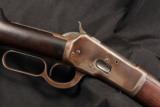 |
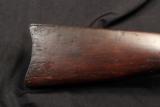 |
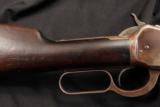 |
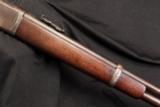 |
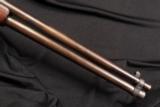 |
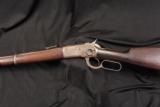 |
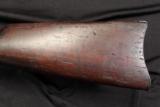 |
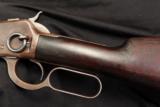 |
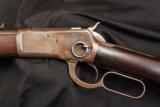 |
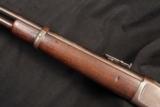 |
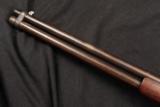 |
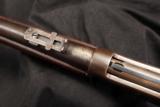 |

Winchester 1892 SRC, DOM 1895-Antique
Guns International #: 100400639 Seller's Inventory #: 56889
Category: Winchester Rifles - Model 1892 - Winchester Rifles - Antique Lever
Seller's Information
When emailing or calling sellers direct, please mention that you saw their listing on GunsInternational.com
Seller: Class2NFA
Company: Symbiotic Solutions LLC
Member Since: 8/5/13
First Name: Rick
Last Name: Dunagan
State: Colorado
Zip: 80919
Country: United States
Phone: (719) 338-5378
Fax:
Number of Active Listings: 0
Total Number of Listings: 34
Seller: FFL Dealer
Return Policy: 3 day inspection and return policy on used guns.
3
Payment Types Accepted: All Credit Cards
Description:
Model: 1892 SRC
Serial Number: 77983
Year of Manufacture: 1895
Caliber: .44-40 WCF
Action Type: Lever Action with Tubular Magazine
Barrel Length: 20" The carbine has survived with its original barrel intact. It has no proof marks which is correct for all antique Model 1892's. By way of backgrond: Over a period of years, the rifled bores in barrels, especially carbines simply wore out. Whether they were shot out, not properly cleaned, or damaged, the most feasible solution for the owner was not to junk the gun but to replace it with a new one. Winchester had a thriving business for many years selling mail-order replacement barrels. These are still found today in NOS condition from time to time and even a rumor or two that many were scrapped during WW2. These are denoted by Winchester proofs along with the letter "P" inside a small oval circle. Since it usually took years to wear out a barrel, most replacement barrels are going to be easy to spot as markings on these barrels changed every few years. More often than not, a replaced barrel will fall outside the original gun's period of manufacture and will not have the proper original markings. For example, an antique Winchester 1892 should not have "WP" Winchester proof marks on the barrel or the receiver. This is a sign the gun was returned to the factory for either a new barrel or in some rare cases, simply work on the original barrel that required a proof test. Personally speaking, I have been burned more than once by houses (which will go unnamed here) that seem quite content in overlooking these types of details. This can prove to be costly to collectors so ask lots of questions if a description doesn't cover all the bases. Case in point: some years ago, I won what I thought was a fantastic pre-1898 Model 1892 SRC through a live online only to discover upon arrival some weeks later that it had a 1930's era mail order replacement barrel. What a disappointment this was, not to mention a serious jolt to my wallet! Fortunately, that's not the case here. Origional factory barrel on this rifle. This rifle has NO factory "WP" proof marks on the barrel indication origional factory barrel on this rifle (many were retrofitted with replacement barrels from Winchester whcih contain the letter "P" inside a small oval circle.
Markings: The left side of the barrel is marked “Manufactured By ... / Winchester Repeating A...” and “44 W.C.F.” The 44 WCF may have been re-struck. The serial number is on the underside of the frame. The upper tang is marked “Model 1892 / Winchester / Pat. Oct. 14 1884”. There is a "5" on the underside of the frame by the lever. Antique Arms notes the following factoids about the early1892 Winchesters:
- This rifle has the perid correct 2-line Winchester address located on the top just to the front of the rear sight (see photo). Later barrels will have patent dates added (circa 1903-4)...while early guns have their patent dates located on the upper tang. Behind the sight is the caliber marking "44 W.C.F." which is correct on early 1892's. Later production, Winchester shifted both the barrel address and caliber marking from the top over to the left hand side just above the forewood
- This rifle has period correct TANG MARKINGS: this gun has its correct tang markings which we'll explain: the first 1892's had (approx. 1892-1902) inventor John Browning's patent date "OCT. 14. 1884" (the same patent for the Model 1886) located on the top of the upper tang along with the "Winchester" name and the Model 1892 designation. By the early 1900's Winchester shifted the patent date from the tang to the barrel address. In fact, there is a bit of transition period where you'll see turn-of-the-century Model 1892's with the patent date on both the upper tang and tacked on to the end of the barrel address.
- This rifle has the period correct Buttplate: Did you know that the vast majority of carbine buttplates used on the Models 1892 and 1894 were blued? These new buttplates were much thinner than buttplates found on the Model 1873, 1886, and 1876 carbines and Winchester soon figured out they could save money by bluing them around the turn of the century. However, the early buttplates on the 1892 and 1894 used the traditional case color hardened finish. This gun is no exception and you can clearly see original colors along the top tang of the plate. Just another little detail to keep in mind when purchasing an early 1892 or 1894 carbine that sets these apart from the bulk of production.
- This rifle has Origional Wood: originally, the Models 1892 and 1894 saddle ring carbines used buttstocks and forends made of American walnut. These early carbines with walnut had great lines, especially along the combs and tops of the buttstock. Around the turn of the century, if I had to guess I'd say it was around 1904-6, Winchester switched from walnut to gumwood on the 1892, 1894, and eventually 1873 carbines. According to George Madis, author of The Winchester Book, gumwood saved about 1/3 of the weight of the wood. It was cheap and durable. This was a popular trend around the turn of the 20th century as American forests were being depleted of their virgin timber. You'll find a lot of American furniture made out of gumwood around this timeframe and furniture companies loved it because could be finished to look like more expensive woods. The problem with gumwood on guns was that once the thin veneer of varnish wore away and the natural tones of the wood became exposed, it was just plain ugly to look at. Gumwood was used heavily on almost all Winchester carbines except the Model 1895 right through World War One up to around 1922. Then, with the war now over, walnut was more readily available and it reemerges on all Winchester carbines. This later walnut from the 1920's is very similar to the original walnut used in the 1890's except that the fine comb and sharp clean lines are now more clubby looking and rounded. The wood-to-metal fit is also a bit more perched-looking. This carbine has its original walnut wood with its fantastic sharp early style stock comb and it's in great shape. Lastly, the wood on carbines was usually oil-finished in contrast to varnished stocks found on sporting rifles.
- Finish: This rifle has all of its original finishes. Frames were blued along barrel bands, barrels, and magazine tubes. Loading ports and extractors will sport an even brighter fire blue. The lever, hammer, and buttplates on early production 1892 carbines were case color hardened.
Sights / Optics: The gun is mounted with a standard carbine front sight, fixed in a base. The rear sight is a carbine style flip-up ladder sight, with the set screw.
Stock Configuration & Condition: The stocks are original pieces that fit very well. The stock is very dark and has never been sanded. There are many dings, marks and gouges, with several cracks at the butt including evidence of a sling pivot bolt which had been installed at one time. The forearm is lighter in color, though it shows plenty of natural wear and age. The LOP measures 12 ¾” from the front of the trigger to the back of the carbine style plate. The stocks rate in about Good overall condition.
Type of Finish: Blue
Finish Originality: Now Patina, no evidence of refinishing or cleaning.
Bore Condition: The bore is in suprisingly good condition. Rrifling is worn as typical for a gun of this age but present and shootable. There is very mild erosion. The bore is clean and rifleing evident indicating that this origional frrom the factory barrel has seen little use (and was not replaced - ref: Antiques Firearm's Arcilte here: ://antiquearmsinc/winchester-1892-src-saddle-ring-carbine-38-44-wcf-antique-pre-1898-collectible-firearms-.htm.
Overall Condition: This rifle retains about 1% of its metal finish. The balance of the finish shows a general and light drift to patina. The metal may have been cleaned some time ago, though the patina is natural. There is some "dulling" of the metal and some very even surface frosting under the patina. There are other scattered marks and dings throughout. The lever has been bent to the right as you look at the underside of the gun which could be easily straightend without damaging the gun but adds charcter as it is. The screw heads are lightly worn with a few replacements. The markings are partially obscured on the barrel. Overall, this rifle rates in about Very Good condition.
Mechanics: The action functions correctly, despite the bent lever. We have not fired this rifle.
Box, Paperwork & Accessories: None
Our Assessment: A Winchester designed by John Browning . . . The Model 1892 is one of the most collected and respected Winchester Lever Action Rifles. Everyone wants a SRC, and everyone wants one in .44-40. Good luck with this classic old Winchester, ready for the safe, gun cart, scabbard or the mantle.
We have many additional pictures which we are proud to email to you as you consider this fine investment.
As always, 3 day inspection. Buyer pays return freight.
Shipping & Insurance: $25, Colorado Residence add 7.63% state sales tax. CC sales add 3.8%, AMEX 4%
Antique Firearms Full text article: Great Historical Factoids about the early 1892 Wincheter Rifles:
://antiquearmsinc/winchester-1892-src-saddle-ring-carbine-38-44-wcf-antique-pre-1898-collectible-firearms-.htm
SOLD
Curio/Relic: Yes
Antique: Yes